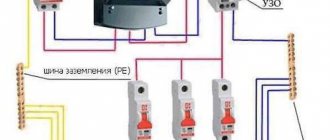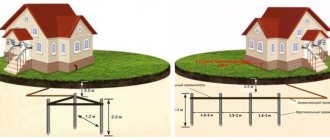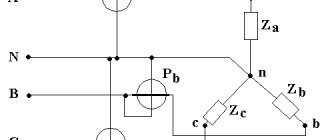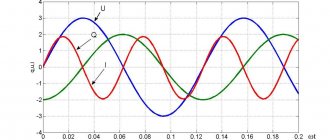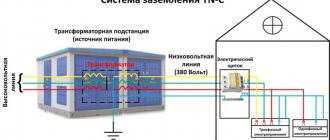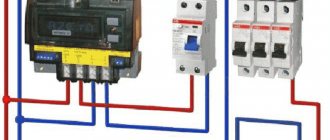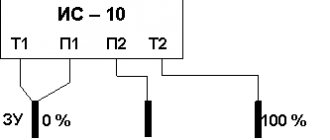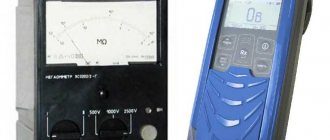Modern apartments and private houses are equipped with a large number of different household appliances. In this regard, protecting people from electric shock comes to the fore. The main protective measures are the installation of circuit breakers - automatic circuit breakers and residual current devices - RCDs. However, in each specific case, in the presence of single- or three-phase networks, questions of a technical nature arise, for example, does an RCD without grounding work or not? In many old houses there is no grounding, so the possibility of using protective devices in these conditions is of particular relevance.
Is grounding required for RCDs?
Many homeowners are confident that the protective device will work correctly only if there is a three-wire electrical circuit, with phase, neutral and ground conductors. For the same reason, the question often arises: which is better? RCD or grounding. In order to give the correct answer, it is necessary to understand the purpose of each of them.
It is known that the main function of an RCD is to turn off equipment when a current leak appears on the housing. Thus, it is possible to avoid electric shock to a person. Grounding is installed for the same purpose, only it works according to a different scheme. When electric current appears on non-current-carrying parts, a short circuit is created due to grounding. As a result, the maximum current protection of the machine is triggered and the equipment is de-energized.
Consequently, both methods of protection can be used separately, and, if necessary, together, complementing each other. Therefore, mandatory installation of grounding when using an RCD is not required and the protective device can be used even in a two-wire single-phase network in which there is no standard grounding. This conclusion is confirmed by the design of the device itself, where there are phase and neutral terminals, but there is no separate terminal for the ground wire. Particular attention should be paid to this, since grounding is mandatory only in modern houses.
In old houses, built during the Soviet era, two-wire networks are still used, without a grounding conductor. In such cases, protective devices are especially necessary. The only difference in the operation of an RCD with grounding and without grounding is only in the response time. In the presence of grounding, operation occurs almost instantly. An RCD without grounding is triggered only at the moment of touching the body of the device, which is energized. Therefore, the degree of protection is no longer as reliable as in the first option, but nevertheless, even in this case, the RCD protects against the unpleasant consequences of electric shock.
The principle of constructing an RCD connection diagram
For correct operation of this protective device in each individual case, the connection diagram to the electrical network should be developed separately. According to professional electricians, the likely location for connecting an ouzo in a residential apartment or country house is considered to be a point in the immediate vicinity of a source of electricity. For qualified work, these devices are used simultaneously with circuit breakers, installed in series. Installation of the electric current network is carried out according to two schemes.
- Scheme 1. If you want to connect one protective device to a common power line, the negative point in this situation is the disconnection of the network when an emergency situation occurs in one of the areas. In this case, the search for the damaged area will take a long time.
- Scheme 2. If it is possible to connect the ouzo on each specific line of the network individually, in the event of an emergency, the supply of energy will occur in a separate damaged area. Electricity continues to flow into the remaining single-phase network, all devices and equipment will continue to function as usual. This scheme requires increased financial costs, but these costs are undeniably justified.
How does an RCD with grounding work?
The residual current device is selected in accordance with the network configuration where it is planned to be installed. The presence or absence of a PE grounding conductor should be immediately determined. In modern buildings it is initially provided for by the design. At old buildings, the PEN scheme is still used, which involves combining the protective conductor with the neutral wire.
Installation of a connection to the ground is considered more effective, since the circuit is disconnected in this case immediately when a current leak occurs. In the PEN scheme, as already noted, shutdown occurs only after direct human contact with the equipment.
If there is still grounding in the circuit, then before installing the protective device, its type should be clarified. For example, the TN circuit assumes solid grounding of the neutral of the power source. Its variation is the TN-C circuit, which combines in a single wire the neutral working and protective conductors throughout the entire electrical circuit. This simple and inexpensive option has a significant drawback: in the event of a break in the PEN conductor, if the device has its own grounding, there is a danger that the entire potential will transfer to its body and the same voltage will appear on it as in the entire circuit.
Sometimes electricians use a jumper that shorts the neutral and ground terminals in the outlet. Such a scheme is considered incorrect and dangerous due to the high probability of electric shock. When the PEN wire breaks, the RCD will not trip, and dangerous voltage will appear on the device body. Injury can only be avoided by accident: at the moment of contact with a current-dangerous housing, a person must also touch the grounding circuit, for example, water supply or heating pipes.
The TN-S circuit is considered the most reliable for connecting an RCD, where the neutral protective conductor is connected separately. It is combined with the neutral only in the power source, which ensures maximum protection and almost completely eliminates the possibility of electric shock. Even if the neutral or ground wire breaks, all devices in the circuit will continue to work. Dangerous voltage will not appear on the housings, since the potential will transfer to the other, remaining wire. If two wires break at once, all devices and the circuit itself will not pose a danger to people, since the electricity will be completely turned off.
There is another so-called intermediate connection scheme TN-CS, when the neutral and ground wires can be combined only in separate sections and acquire the properties of a PEN conductor. In this case, installation of an RCD is mandatory, otherwise the circuit will be left without protection at all.
Leakage current and general protection circuit
For an apartment with TN-CS wiring, it would not be a mistake to take an RCD for 30 mA unbalance without further thought. A separate section will be devoted to the TN-C apartment system, but for private houses it is impossible to immediately give clear and definitive recommendations.
According to clause 7.1.83 of the PUE, the operating (natural) leakage current should not exceed 1/3 of the RCD unbalance current. But in a house with an electric heated floor in the hallway, courtyard lighting and electric heating of the garage in winter, the operating leakage current can reach 20-25 mA with a living area of 60 and 300 square meters.
In general, if there is no greenhouse with electrically heated soil, a heated water well, and the yard is illuminated by housekeepers, at the input after the meter it is often enough to install a fire RCD with a rated current one step higher than the cut-off current of the machine, and for each group of consumers - a protective RCD with the same rated current. But an accurate calculation can only be made by a specialist based on the results of electrical measurements of finished wiring.
Calculation examples
Let's look at how to calculate an RCD using examples for different cases.
The first is a new apartment with TN-CS wiring ; According to the data sheet, the power consumption limit is 6 kW (30 A) . We check the machine - it is at 40 A, everything is OK. We take the RCD a step or two higher in rated current - 50 or 63 A, it doesn’t matter - and for an unbalance current of 30 mA. We don’t think about the leakage current: the builders must provide it within normal limits, but if not, let them fix it themselves for free. However, contractors do not allow such mistakes - they know what replacing electrical wiring under warranty smells like.
Second. Khrushchevka, 16 A plugs. We install a 3 kW washing machine; current consumption is about 15 A. To protect it (and protect against it) you need an RCD with a rating of 20 or 25 A for 30 mA imbalance, but 20 A RCDs are rarely on sale. We take a 25 A RCD, but in any case, it is MANDATORY to remove the plugs and install a 32 A machine instead, otherwise the situation described at the beginning is possible. If the wiring clearly cannot withstand a short-term surge of 32 A, nothing can be done, you need to change it.
In any case, you need to submit an application to the energy service to replace the meter and reconstruct the electrical wiring, with or without replacement. This procedure is not very complicated and troublesome, and a new meter with an indication of the wiring status will serve you well in the future, see the section on errors and malfunctions. And the RCD registered during reconstruction will then allow you to call electricians for free for measurements, which is also very good for the future.
Third. A cottage with a consumption limit of 10 kW, which gives 50 A. The total leakage according to the measurement results is 22 mA, with the house giving 2 mA, the garage - 7, and the yard - 13. We set the general difavtomat to 63 A cutoff and 100 mA imbalance, house with the garage we power it separately through an RCD for 80 A nominal and 30 mA unbalance. In this case, it is better to leave the yard without its own RCD, but take the lamps for it in waterproof cases with a grounding terminal (industrial type), and connect their grounds directly to the ground loop, this will be more reliable.
Will an RCD work without grounding?
The operation of a protective device in a two-wire network occurs under special conditions. Therefore, many owners have a question: will the RCD work without grounding and will it provide protection against electric shock? In order to get an answer, it is necessary to trace the entire triggering mechanism. When a breakdown occurs on the equipment body, the RCD will not immediately trigger, since there is no grounding and there is no path for the current leak to pass further. At the same time, a potential is generated on the device body that is dangerous to human health and life.
At the moment of touching the body, the current leakage path to the ground will pass through the human body. After a certain period of time, the current value will become equal to the RCD response threshold and only then will a shutdown occur, stopping the supply of current to the faulty device. The time a person remains exposed to current will depend on the activation setting of the protective device. Despite the fairly quick shutdown, this is quite enough to cause serious electrical injury. If there was a grounding, the RCD would operate immediately after a current leak and would turn off the device before a person came into contact with it.
Thus, an RCD without grounding can be connected, but such a circuit does not guarantee 100% safety. However, older houses still use two-wire networks, and converting them to more modern three-wire networks is not always possible from a technical point of view. Therefore, in many cases, an RCD is the only option for protecting people and household appliances. When using circuits without grounding, circuit breakers must be installed together with residual current devices to disconnect the network in case of overloads and short circuits.
How to connect an RCD in an apartment without grounding - Scheme No. 1
The only protective device is installed at the entrance and covers all wiring in the apartment. Voltage is supplied to the distribution panel through the input cable. Then it goes to a two-pole circuit breaker, and then to an RCD. After this, the machines are installed on the outgoing lines.
A significant advantage is the low cost of such a scheme due to the use of only one protective device. All devices can be compactly placed even in a small distribution panel. But, a significant drawback of such a shutdown will be the tripping of the RCD during current leaks, as a result of which the entire apartment will be de-energized.
Scheme No. 2
The operation of an RCD without grounding can be carried out according to one more scheme. In this case, protective devices are installed not only at the entrance, but also on each outgoing branch. The incoming RCD is installed in the same way as in the previous version, and all the others are installed after the circuit breakers protecting the outgoing lines. The total number of security devices will depend on the specific home network configuration. Often water heaters, electric stoves, dishwashers and washing machines are separately connected to the protection.
Basic principles of connection
To connect the RCD in the panel, two conductors are needed.
Through the first of them, the current flows to the load, and through the second, it leaves the consumer along the external circuit. As soon as current leakage occurs, a difference appears between its values at the input and output. When the result exceeds a predetermined value, the RCD is triggered in emergency mode, thereby protecting the entire apartment line.
Residual current devices are negatively affected by short circuits (short circuits) and voltage surges, so they themselves need to be covered. The problem is solved by including automata in the circuit.
The RCD contains a ring-shaped core with two windings. The windings are identical in their electrical and physical characteristics
The current powering electrical appliances flows through one of the core windings in one direction. It has a different direction in the second winding after passing through them.
Independent installation of protection devices involves the use of diagrams. Both modular RCDs and machines for them are installed in the panel.
Before starting installation, you need to resolve the following issues:
- how many RCDs should be installed;
- where they should be in the diagram;
- how to connect so that the RCD works correctly.
The rule of electrical installation is that all connections in a single-phase network must enter the connected devices from top to bottom.
Professional electricians explain this by saying that if you start them from below, the efficiency of the vast majority of machines will decrease by a quarter. In addition, the foreman working in the switchboard will not have to further understand the circuit.
RCDs designed for installation on separate lines and with low ratings cannot be installed in a general network. Failure to comply with this rule will increase both the likelihood of leaks and short circuits.
Conclusion
As already said at the beginning, RCD is not a panacea for the electronic threat. It repeatedly reduces the possibility of electric shock, but electricity still does not tolerate thoughtless and irresponsible handling of it.
The best option for developing electrical safety measures is the widespread use of chip sockets and electrical differential RCDs integrated into electrical installations. In this case, even the TN-C power supply system, while maintaining its efficiency, could become completely harmless.
